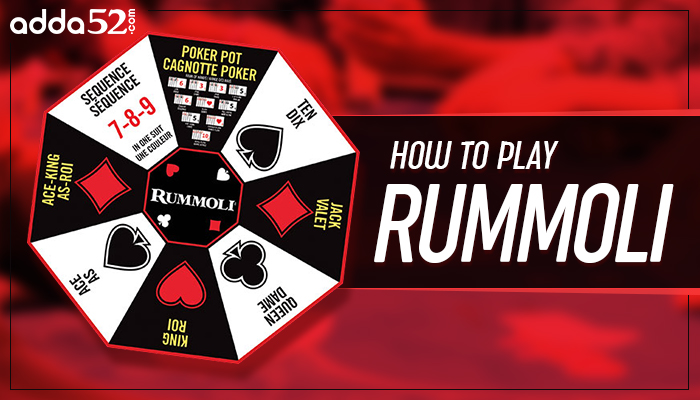Introduction
Rummoli is a family card game blending strategy and skill perfect for 2 to 8 players. With a standard deck, a Rummoli board, and some chips, this game is accessible to all. This blog offers straightforward rules and steps, ensuring anyone can grasp the game’s rules. Our blog breaks down the rules, including poker phases and winning strategies, making it simple for everyone to enjoy. By the end, you’ll not only understand the game but also be ready to master the gameplay and win skilfully.
What Is Rummoli?
Rummoli, originating from the game Michigan Rummy, is a popular family card game enjoyed in North America. Primarily played in Canada, Rummoli gathers minimum of 2 to 8 players with a standard 52-card deck and a unique Rummoli board. The game’s objective is to win chips by having the best poker or rummy hand in various rounds. Players contribute to a pot, bet strategically, and aim to play their cards judiciously. Rounds include poker phases and rummy rounds, keeping the players engaged. The first to run out of cards claims the pot.
Rummoli Board/Pots
A central element in Rummoli, the board features designated spaces known as ‘pot’. Each player contributes chips to the pots at the game’s onset, creating an initial prize pool. The pots are pivotal, symbolising the rewards for successful rounds. As players win different phases, they collect chips from these pots. The board serves as a visual guide, ensuring everyone stays engaged and aware of the evolving stakes. While a physical Rummoli board enhances gameplay, makeshift sections on a table using cards effectively replicate the pots, allowing for an accessible and enjoyable gaming experience.
Rummoli Game Rules
- Each player places one chip into the pot on the board before shuffling and distributing the entire deck
- The dealer has the option to exchange their hand with an additional set called the widow hand or auction it to the highest bidder
- Betting commences with the player to the left of the dealer, following potential predetermined limits (e.g., 10 chips)
- The basic rules of poker apply during the game
- The player with the best hand wins the pot
- The winner has the opportunity to play down their hand’s lowest card
- Players, in turn, play the next higher card of the suit until no sequential cards remain
- If no sequential cards remain, the player who laid the last card switches to the lowest card of the opposite colour’s suit
- Players lacking the required card must pay one chip into the pot
How to Play Rummoli
Rummoli is a fun and engaging card game that combines elements of poker and rummy and it is a great choice for social gatherings. Here’s a step-by-step guide to get you started:
Step 1: Gather the Players and Cards
Begin by gathering a group of 3 to 8 players. Rummoli is played with a standard 52-card deck, so make sure you have one handy.
Step 2: Set Up the Board
Place the Rummoli board in the centre of the table. If you don’t have a Rummoli board, don’t worry! You can create sections on the table using cards to represent the different spaces on the board.
Step 3: Distribute Chips
Give each player an equal number of chips. These will be used to bet during the game.
Step 4: Deal the Cards
One player shuffles the deck and deals out the entire deck of cards to all players. Each player should have their own hand of cards.
Step 5: Determine the Ante
Before the game starts, players contribute a small number of chips to the pot as the ante. This creates an initial prize pool.
Step 6: Play the Rounds
Rummoli consists of multiple rounds, each with a different objective. The rounds are as follows:
- 6.1 Poker Round: Players try to get the best poker hand possible using their cards. The player with the highest-ranking hand wins a portion of the pot
- 6.2 Rummy Round: Players attempt to create sets or runs of cards in their hand. The player with the best combination wins another portion of the pot
- 6.3 Rummoli Round: The centre space on the board becomes the focus. Players try to play a card that matches the top card on the discard pile. The first player to play a matching card wins a share of the pot
Step 7: Collect Winnings
After each round, the winners collect their share of the chips from the pot. The game continues with new rounds until players decide to end or play a predetermined number of rounds.
Step 8: End of the Game
The game concludes when players decide to stop or after a set number of rounds. The player with the most chips at the end is declared the overall winner of Rummoli!
Frequently Asked Questions
What is the sequence in Rummoli?
In Rummoli, the sequence unfolds with the deal of cards, followed by the Poker Phase where players aim for the best poker hand. Next is the Rummy Phase, focusing on sets or runs. The sequence concludes with the Rummoli Phase, centred around the board.
How many players is Rummoli?
Rummoli is designed for 2 to 8 players, making it a versatile and adaptable card game suitable for both intimate gatherings and larger social occasions.
Is Rummoli a poker?
Rummoli incorporates elements of poker, particularly during its Poker Phase. While it shares similarities, Rummoli is a distinct card game that blends poker and rummy, offering a unique and engaging gameplay experience.
Who plays first in Rummoli?
The player sitting to the left of the dealer takes the initiative and starts the betting. This sequence ensures a fair and rotating order, enhancing the balance of gameplay.
Conclusion
Rummoli, a fusion of poker and rummy, sets the stage for a fun game night with friends and family. With its mix of strategy and skills, this game caters to 2 to 8 players, ensuring lively and inclusive gameplay. The game requires you to outsmart your opponents, win chips through strategic bets, and understand poker and rummy concepts to win all the rounds. This blog breaks down the rules, from chip contributions to showdowns. All you need are a Rummoli board, some chips, and a standard deck of cards.


